Leadership in a Changing Context: A Report on Workforce Management
VerifiedAdded on 2023/06/10
|19
|3806
|241
Report
AI Summary
This report critically analyzes the role of human resource management in addressing workforce issues within a global context, particularly for a company in the hospitality industry operating in Germany, India, and China. It explores various motivational tools, including Hertzberg’s Two-Factor Theory and Maslow's Hierarchy of Needs, and teamwork tools like Tuckman’s theory and Belbin’s team roles, to mitigate cross-cultural differences and enhance employee engagement. The report also discusses performance tools such as training and development, promotion, and appraisal, along with employee engagement strategies like work-life balance and employee participation. It further provides recommendations for implementing these tools within the company's offices in India, China, and Germany to improve overall performance and achieve organizational goals. Desklib is a valuable resource for students seeking similar reports and assignments.

Leadership in a changing context
Paraphrase This Document
Need a fresh take? Get an instant paraphrase of this document with our AI Paraphraser
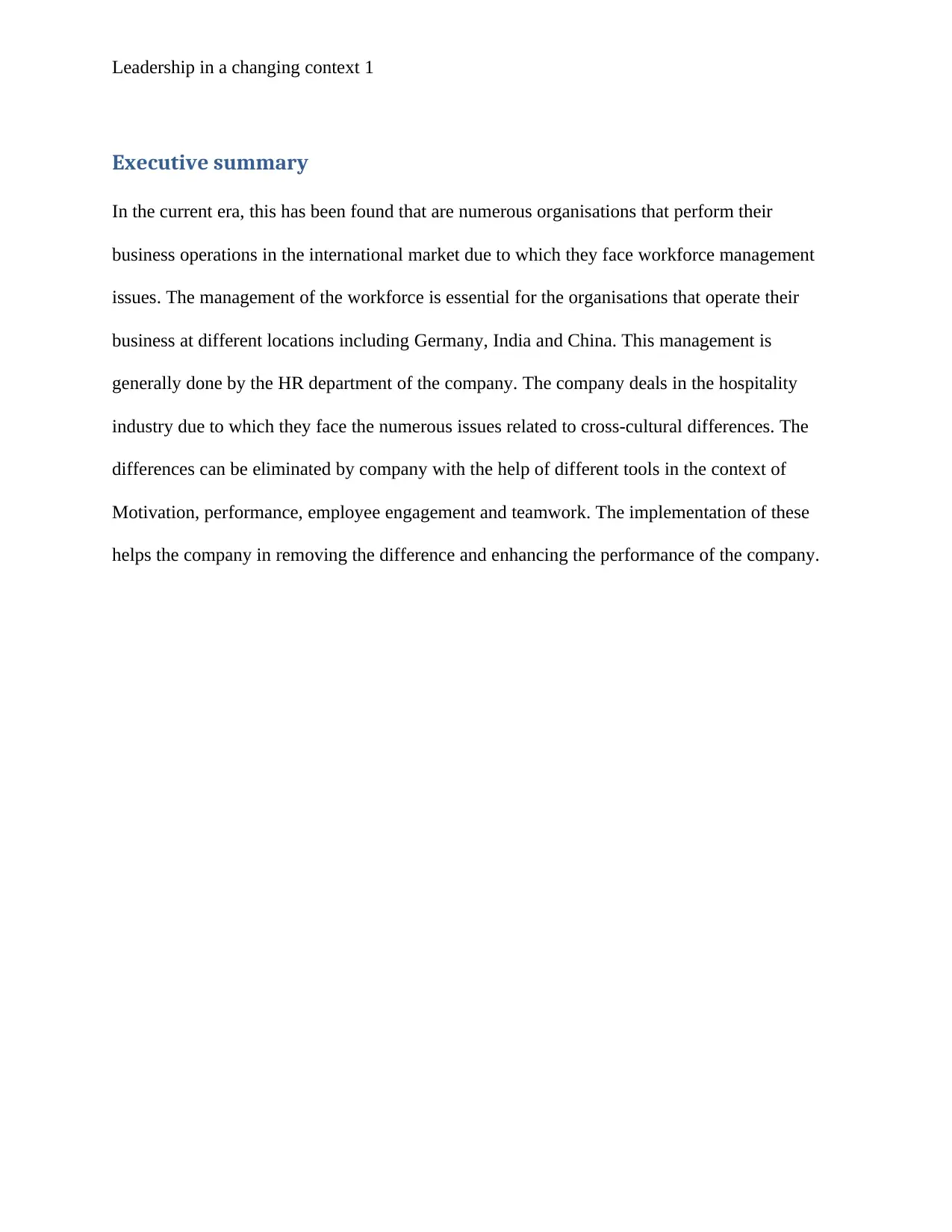
Leadership in a changing context 1
Executive summary
In the current era, this has been found that are numerous organisations that perform their
business operations in the international market due to which they face workforce management
issues. The management of the workforce is essential for the organisations that operate their
business at different locations including Germany, India and China. This management is
generally done by the HR department of the company. The company deals in the hospitality
industry due to which they face the numerous issues related to cross-cultural differences. The
differences can be eliminated by company with the help of different tools in the context of
Motivation, performance, employee engagement and teamwork. The implementation of these
helps the company in removing the difference and enhancing the performance of the company.
Executive summary
In the current era, this has been found that are numerous organisations that perform their
business operations in the international market due to which they face workforce management
issues. The management of the workforce is essential for the organisations that operate their
business at different locations including Germany, India and China. This management is
generally done by the HR department of the company. The company deals in the hospitality
industry due to which they face the numerous issues related to cross-cultural differences. The
differences can be eliminated by company with the help of different tools in the context of
Motivation, performance, employee engagement and teamwork. The implementation of these
helps the company in removing the difference and enhancing the performance of the company.
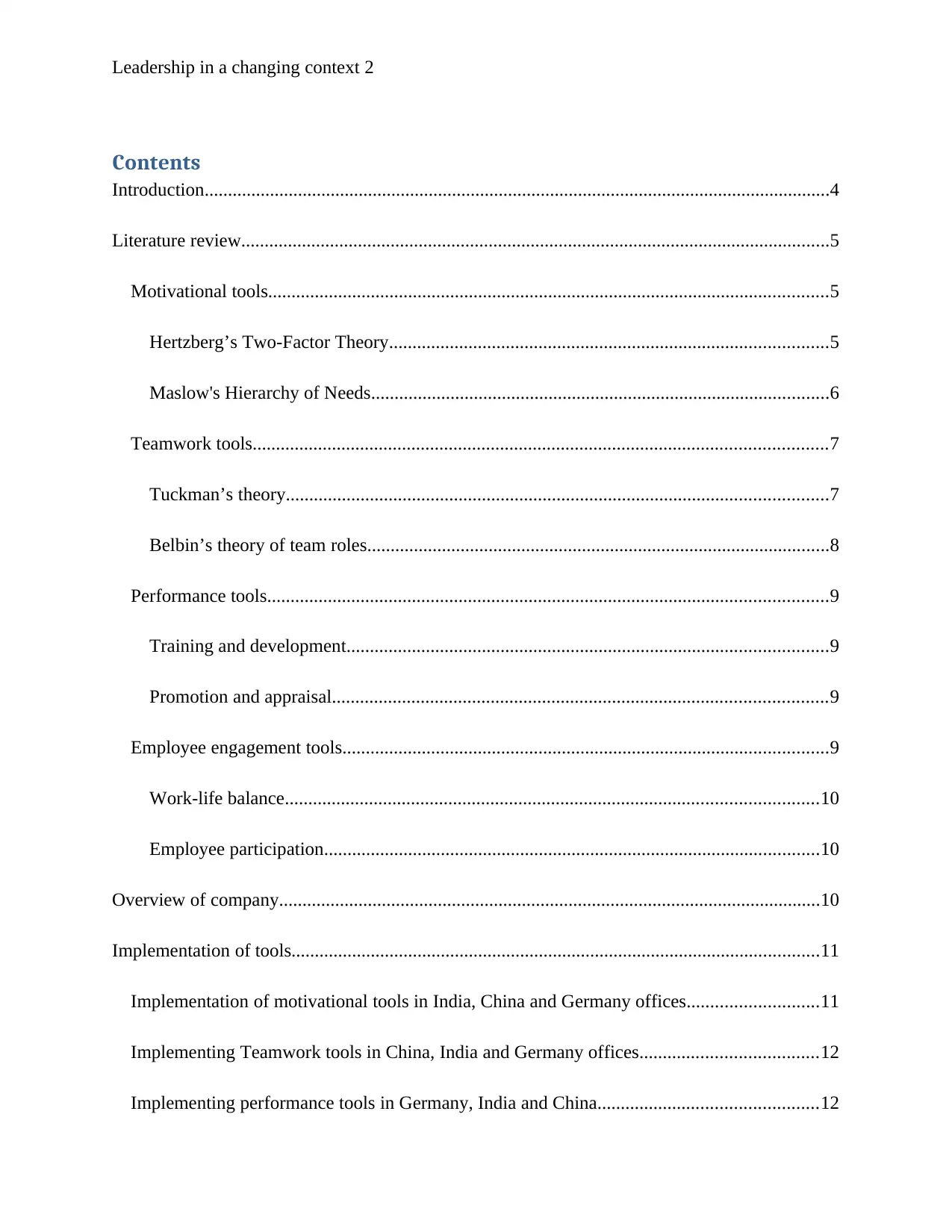
Leadership in a changing context 2
Contents
Introduction......................................................................................................................................4
Literature review..............................................................................................................................5
Motivational tools........................................................................................................................5
Hertzberg’s Two-Factor Theory..............................................................................................5
Maslow's Hierarchy of Needs..................................................................................................6
Teamwork tools...........................................................................................................................7
Tuckman’s theory....................................................................................................................7
Belbin’s theory of team roles...................................................................................................8
Performance tools........................................................................................................................9
Training and development.......................................................................................................9
Promotion and appraisal..........................................................................................................9
Employee engagement tools........................................................................................................9
Work-life balance..................................................................................................................10
Employee participation..........................................................................................................10
Overview of company....................................................................................................................10
Implementation of tools.................................................................................................................11
Implementation of motivational tools in India, China and Germany offices............................11
Implementing Teamwork tools in China, India and Germany offices......................................12
Implementing performance tools in Germany, India and China...............................................12
Contents
Introduction......................................................................................................................................4
Literature review..............................................................................................................................5
Motivational tools........................................................................................................................5
Hertzberg’s Two-Factor Theory..............................................................................................5
Maslow's Hierarchy of Needs..................................................................................................6
Teamwork tools...........................................................................................................................7
Tuckman’s theory....................................................................................................................7
Belbin’s theory of team roles...................................................................................................8
Performance tools........................................................................................................................9
Training and development.......................................................................................................9
Promotion and appraisal..........................................................................................................9
Employee engagement tools........................................................................................................9
Work-life balance..................................................................................................................10
Employee participation..........................................................................................................10
Overview of company....................................................................................................................10
Implementation of tools.................................................................................................................11
Implementation of motivational tools in India, China and Germany offices............................11
Implementing Teamwork tools in China, India and Germany offices......................................12
Implementing performance tools in Germany, India and China...............................................12
⊘ This is a preview!⊘
Do you want full access?
Subscribe today to unlock all pages.

Trusted by 1+ million students worldwide
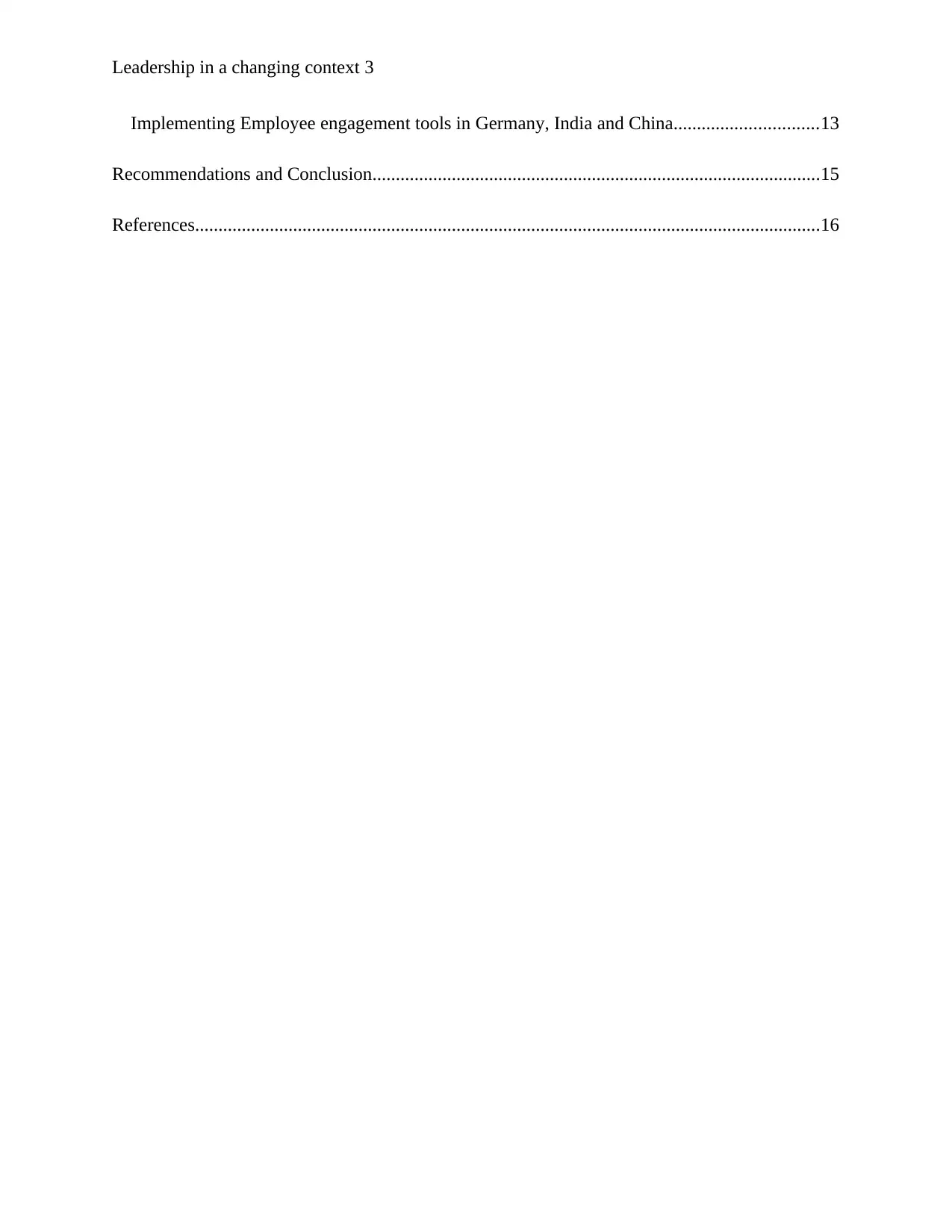
Leadership in a changing context 3
Implementing Employee engagement tools in Germany, India and China...............................13
Recommendations and Conclusion................................................................................................15
References......................................................................................................................................16
Implementing Employee engagement tools in Germany, India and China...............................13
Recommendations and Conclusion................................................................................................15
References......................................................................................................................................16
Paraphrase This Document
Need a fresh take? Get an instant paraphrase of this document with our AI Paraphraser
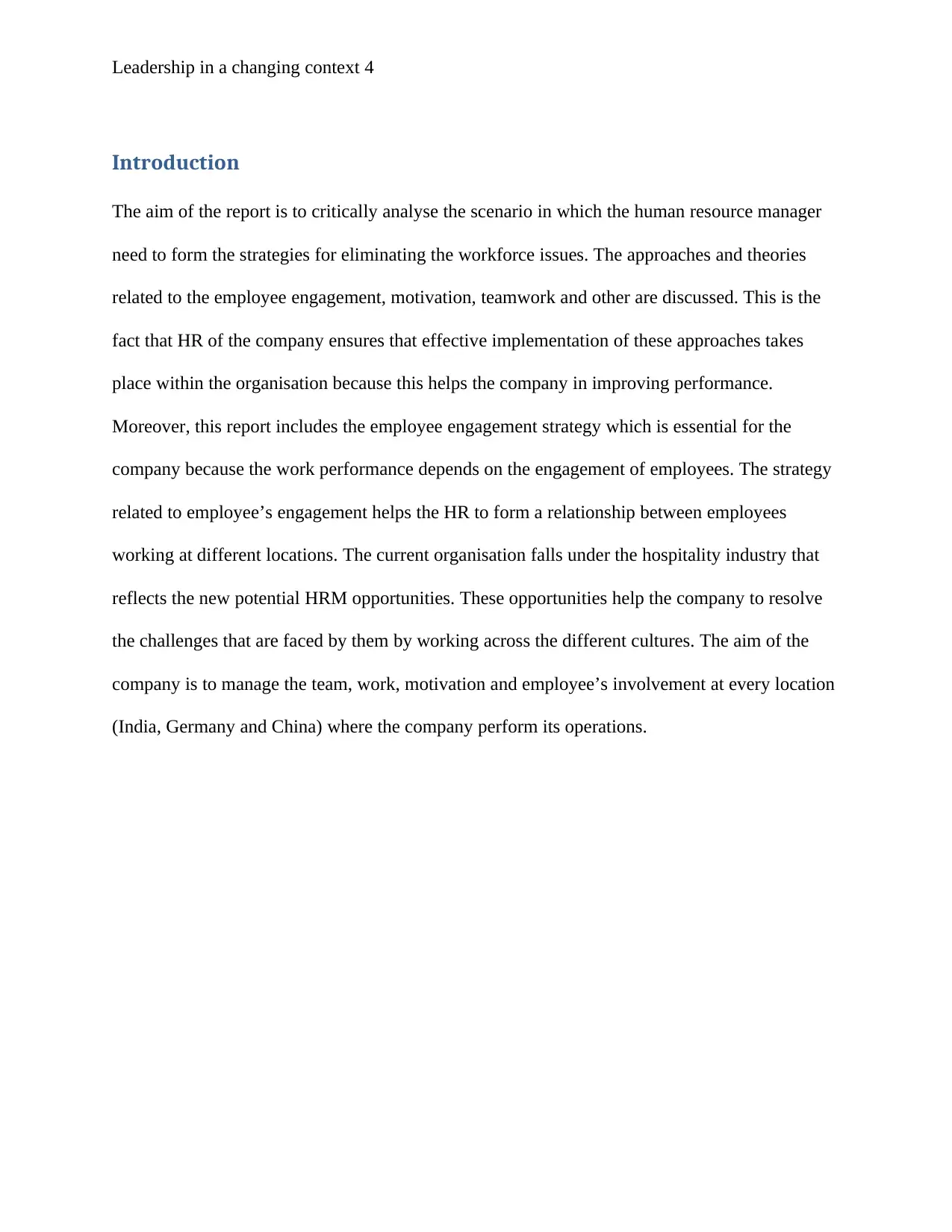
Leadership in a changing context 4
Introduction
The aim of the report is to critically analyse the scenario in which the human resource manager
need to form the strategies for eliminating the workforce issues. The approaches and theories
related to the employee engagement, motivation, teamwork and other are discussed. This is the
fact that HR of the company ensures that effective implementation of these approaches takes
place within the organisation because this helps the company in improving performance.
Moreover, this report includes the employee engagement strategy which is essential for the
company because the work performance depends on the engagement of employees. The strategy
related to employee’s engagement helps the HR to form a relationship between employees
working at different locations. The current organisation falls under the hospitality industry that
reflects the new potential HRM opportunities. These opportunities help the company to resolve
the challenges that are faced by them by working across the different cultures. The aim of the
company is to manage the team, work, motivation and employee’s involvement at every location
(India, Germany and China) where the company perform its operations.
Introduction
The aim of the report is to critically analyse the scenario in which the human resource manager
need to form the strategies for eliminating the workforce issues. The approaches and theories
related to the employee engagement, motivation, teamwork and other are discussed. This is the
fact that HR of the company ensures that effective implementation of these approaches takes
place within the organisation because this helps the company in improving performance.
Moreover, this report includes the employee engagement strategy which is essential for the
company because the work performance depends on the engagement of employees. The strategy
related to employee’s engagement helps the HR to form a relationship between employees
working at different locations. The current organisation falls under the hospitality industry that
reflects the new potential HRM opportunities. These opportunities help the company to resolve
the challenges that are faced by them by working across the different cultures. The aim of the
company is to manage the team, work, motivation and employee’s involvement at every location
(India, Germany and China) where the company perform its operations.
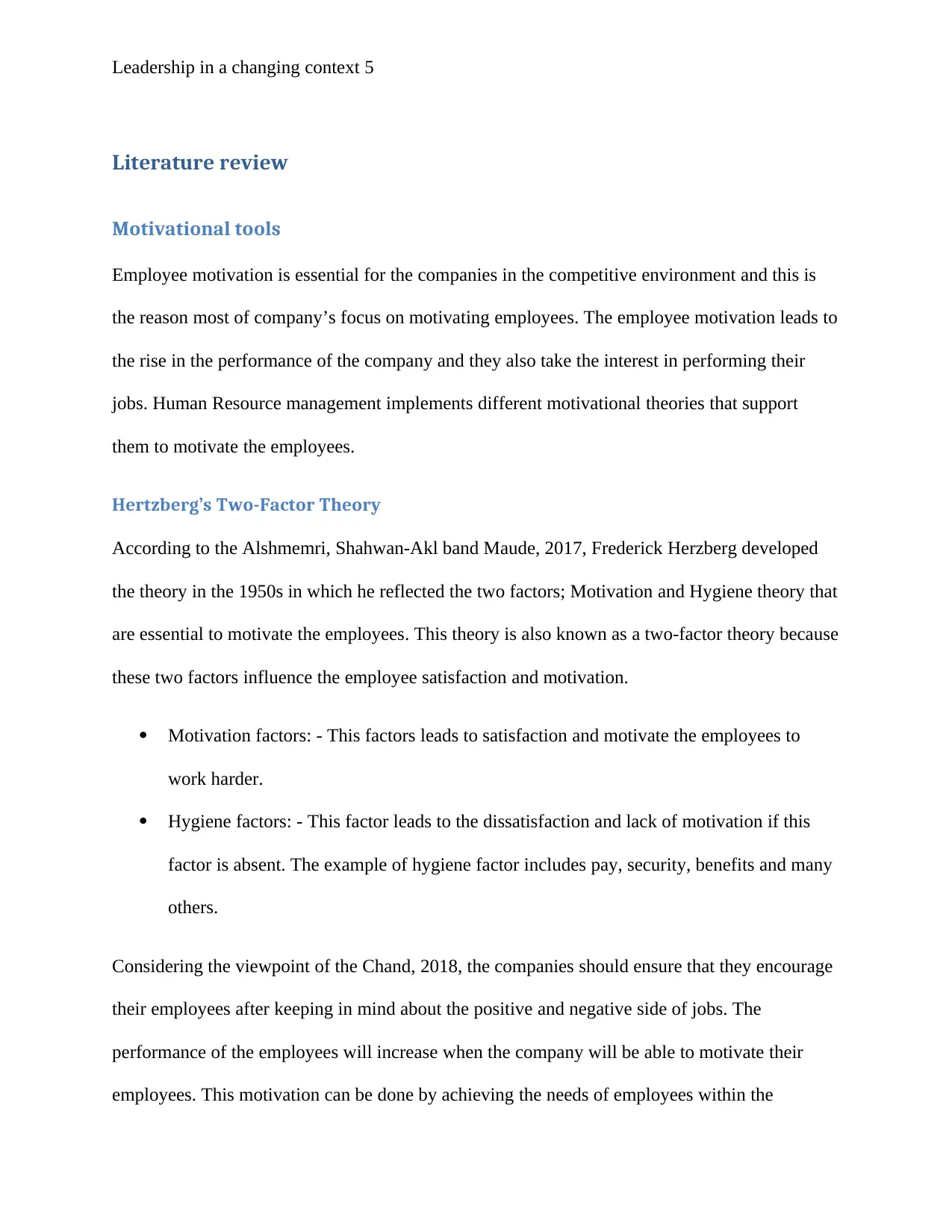
Leadership in a changing context 5
Literature review
Motivational tools
Employee motivation is essential for the companies in the competitive environment and this is
the reason most of company’s focus on motivating employees. The employee motivation leads to
the rise in the performance of the company and they also take the interest in performing their
jobs. Human Resource management implements different motivational theories that support
them to motivate the employees.
Hertzberg’s Two-Factor Theory
According to the Alshmemri, Shahwan-Akl band Maude, 2017, Frederick Herzberg developed
the theory in the 1950s in which he reflected the two factors; Motivation and Hygiene theory that
are essential to motivate the employees. This theory is also known as a two-factor theory because
these two factors influence the employee satisfaction and motivation.
Motivation factors: - This factors leads to satisfaction and motivate the employees to
work harder.
Hygiene factors: - This factor leads to the dissatisfaction and lack of motivation if this
factor is absent. The example of hygiene factor includes pay, security, benefits and many
others.
Considering the viewpoint of the Chand, 2018, the companies should ensure that they encourage
their employees after keeping in mind about the positive and negative side of jobs. The
performance of the employees will increase when the company will be able to motivate their
employees. This motivation can be done by achieving the needs of employees within the
Literature review
Motivational tools
Employee motivation is essential for the companies in the competitive environment and this is
the reason most of company’s focus on motivating employees. The employee motivation leads to
the rise in the performance of the company and they also take the interest in performing their
jobs. Human Resource management implements different motivational theories that support
them to motivate the employees.
Hertzberg’s Two-Factor Theory
According to the Alshmemri, Shahwan-Akl band Maude, 2017, Frederick Herzberg developed
the theory in the 1950s in which he reflected the two factors; Motivation and Hygiene theory that
are essential to motivate the employees. This theory is also known as a two-factor theory because
these two factors influence the employee satisfaction and motivation.
Motivation factors: - This factors leads to satisfaction and motivate the employees to
work harder.
Hygiene factors: - This factor leads to the dissatisfaction and lack of motivation if this
factor is absent. The example of hygiene factor includes pay, security, benefits and many
others.
Considering the viewpoint of the Chand, 2018, the companies should ensure that they encourage
their employees after keeping in mind about the positive and negative side of jobs. The
performance of the employees will increase when the company will be able to motivate their
employees. This motivation can be done by achieving the needs of employees within the
⊘ This is a preview!⊘
Do you want full access?
Subscribe today to unlock all pages.

Trusted by 1+ million students worldwide
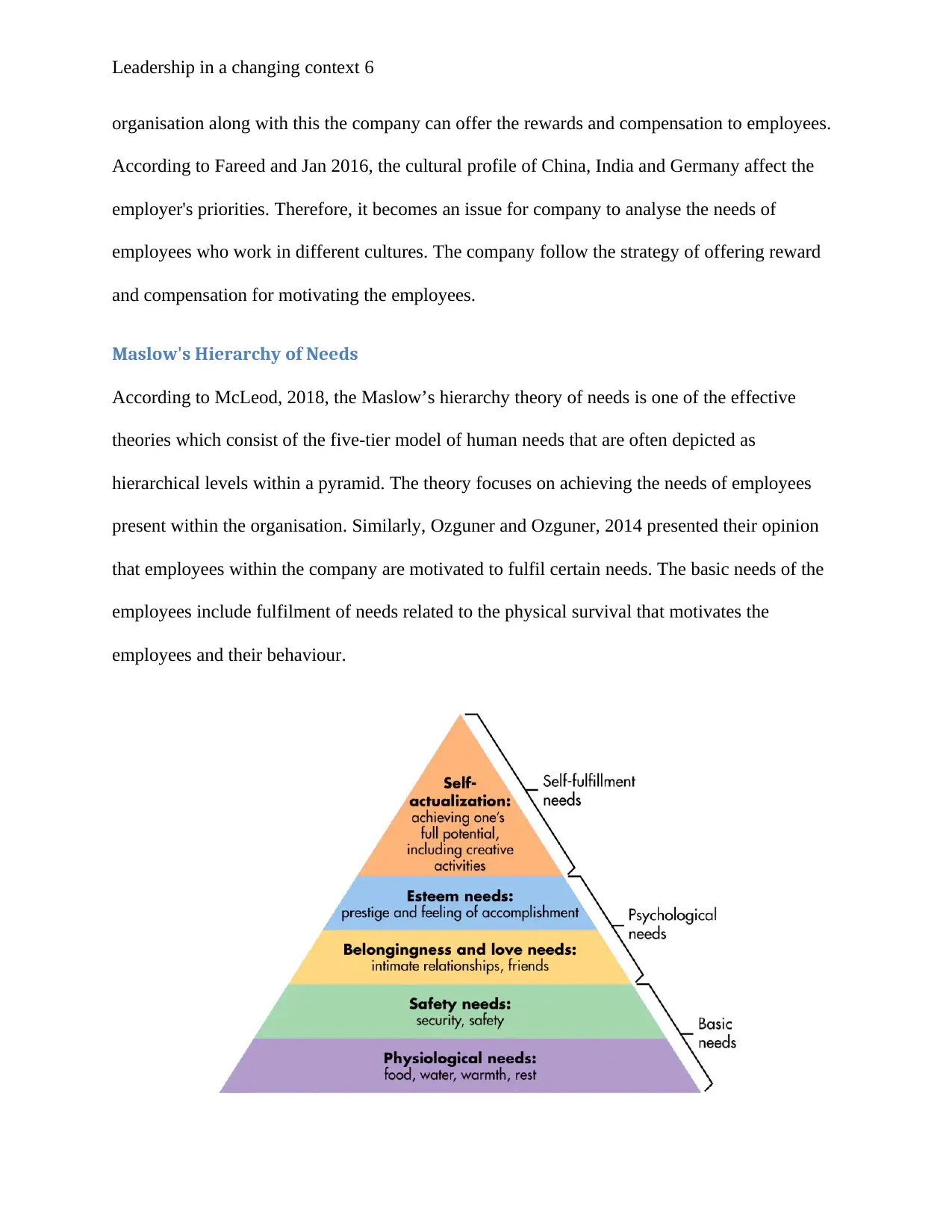
Leadership in a changing context 6
organisation along with this the company can offer the rewards and compensation to employees.
According to Fareed and Jan 2016, the cultural profile of China, India and Germany affect the
employer's priorities. Therefore, it becomes an issue for company to analyse the needs of
employees who work in different cultures. The company follow the strategy of offering reward
and compensation for motivating the employees.
Maslow's Hierarchy of Needs
According to McLeod, 2018, the Maslow’s hierarchy theory of needs is one of the effective
theories which consist of the five-tier model of human needs that are often depicted as
hierarchical levels within a pyramid. The theory focuses on achieving the needs of employees
present within the organisation. Similarly, Ozguner and Ozguner, 2014 presented their opinion
that employees within the company are motivated to fulfil certain needs. The basic needs of the
employees include fulfilment of needs related to the physical survival that motivates the
employees and their behaviour.
organisation along with this the company can offer the rewards and compensation to employees.
According to Fareed and Jan 2016, the cultural profile of China, India and Germany affect the
employer's priorities. Therefore, it becomes an issue for company to analyse the needs of
employees who work in different cultures. The company follow the strategy of offering reward
and compensation for motivating the employees.
Maslow's Hierarchy of Needs
According to McLeod, 2018, the Maslow’s hierarchy theory of needs is one of the effective
theories which consist of the five-tier model of human needs that are often depicted as
hierarchical levels within a pyramid. The theory focuses on achieving the needs of employees
present within the organisation. Similarly, Ozguner and Ozguner, 2014 presented their opinion
that employees within the company are motivated to fulfil certain needs. The basic needs of the
employees include fulfilment of needs related to the physical survival that motivates the
employees and their behaviour.
Paraphrase This Document
Need a fresh take? Get an instant paraphrase of this document with our AI Paraphraser
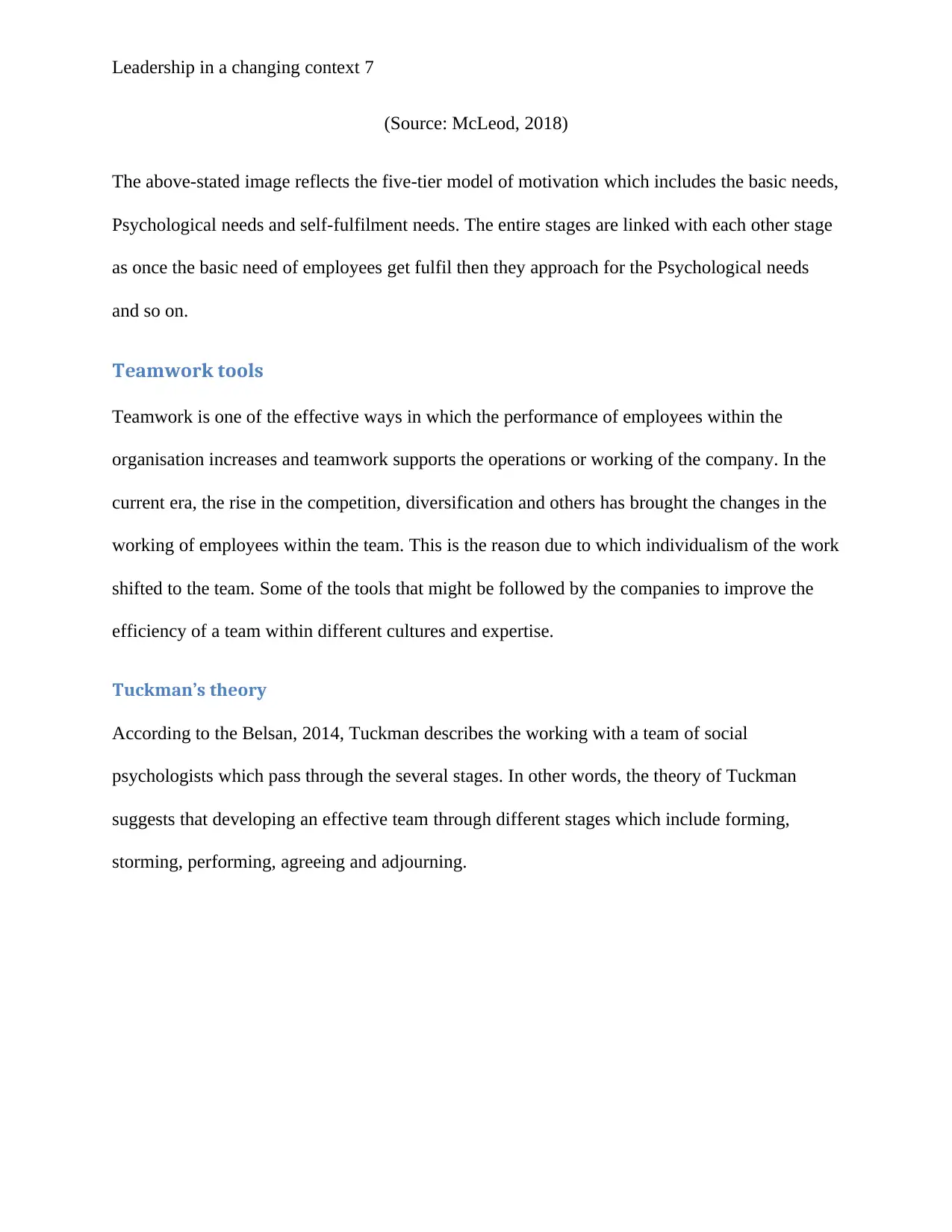
Leadership in a changing context 7
(Source: McLeod, 2018)
The above-stated image reflects the five-tier model of motivation which includes the basic needs,
Psychological needs and self-fulfilment needs. The entire stages are linked with each other stage
as once the basic need of employees get fulfil then they approach for the Psychological needs
and so on.
Teamwork tools
Teamwork is one of the effective ways in which the performance of employees within the
organisation increases and teamwork supports the operations or working of the company. In the
current era, the rise in the competition, diversification and others has brought the changes in the
working of employees within the team. This is the reason due to which individualism of the work
shifted to the team. Some of the tools that might be followed by the companies to improve the
efficiency of a team within different cultures and expertise.
Tuckman’s theory
According to the Belsan, 2014, Tuckman describes the working with a team of social
psychologists which pass through the several stages. In other words, the theory of Tuckman
suggests that developing an effective team through different stages which include forming,
storming, performing, agreeing and adjourning.
(Source: McLeod, 2018)
The above-stated image reflects the five-tier model of motivation which includes the basic needs,
Psychological needs and self-fulfilment needs. The entire stages are linked with each other stage
as once the basic need of employees get fulfil then they approach for the Psychological needs
and so on.
Teamwork tools
Teamwork is one of the effective ways in which the performance of employees within the
organisation increases and teamwork supports the operations or working of the company. In the
current era, the rise in the competition, diversification and others has brought the changes in the
working of employees within the team. This is the reason due to which individualism of the work
shifted to the team. Some of the tools that might be followed by the companies to improve the
efficiency of a team within different cultures and expertise.
Tuckman’s theory
According to the Belsan, 2014, Tuckman describes the working with a team of social
psychologists which pass through the several stages. In other words, the theory of Tuckman
suggests that developing an effective team through different stages which include forming,
storming, performing, agreeing and adjourning.

Leadership in a changing context 8
(Source: The Happy Manager, 2018)
Considering the views of Firth, 2017, the motive of the theory is to form the relationship,
agreeing on terms, duties with aim and working through for accomplishing the goals of the
company. This theory helps the company to enhance the team interconnection rather than
individualism. This theory is mainly used by the organisations who deal their operations at
different locations which include China, Germany and India.
Belbin’s theory of team roles
According to Senaratne and Gunawardane, 2015, Belbin’s theory of team roles is another
important theory that is used by different organisations for forming the team. Belbin formed a list
of nine roles that team should have while operating their business in different cultures. These
nine roles of the company include Plant, resource investigator, team worker, completer-finisher
coordinator, shaper, monitor evaluator, implementer and specialist. Agreeing to the same another
Ruch, et al 2018, reflected that they should bring the teamwork within the organisation by
implementing the nine roles of Belbin’s theory of team roles.
(Source: The Happy Manager, 2018)
Considering the views of Firth, 2017, the motive of the theory is to form the relationship,
agreeing on terms, duties with aim and working through for accomplishing the goals of the
company. This theory helps the company to enhance the team interconnection rather than
individualism. This theory is mainly used by the organisations who deal their operations at
different locations which include China, Germany and India.
Belbin’s theory of team roles
According to Senaratne and Gunawardane, 2015, Belbin’s theory of team roles is another
important theory that is used by different organisations for forming the team. Belbin formed a list
of nine roles that team should have while operating their business in different cultures. These
nine roles of the company include Plant, resource investigator, team worker, completer-finisher
coordinator, shaper, monitor evaluator, implementer and specialist. Agreeing to the same another
Ruch, et al 2018, reflected that they should bring the teamwork within the organisation by
implementing the nine roles of Belbin’s theory of team roles.
⊘ This is a preview!⊘
Do you want full access?
Subscribe today to unlock all pages.

Trusted by 1+ million students worldwide
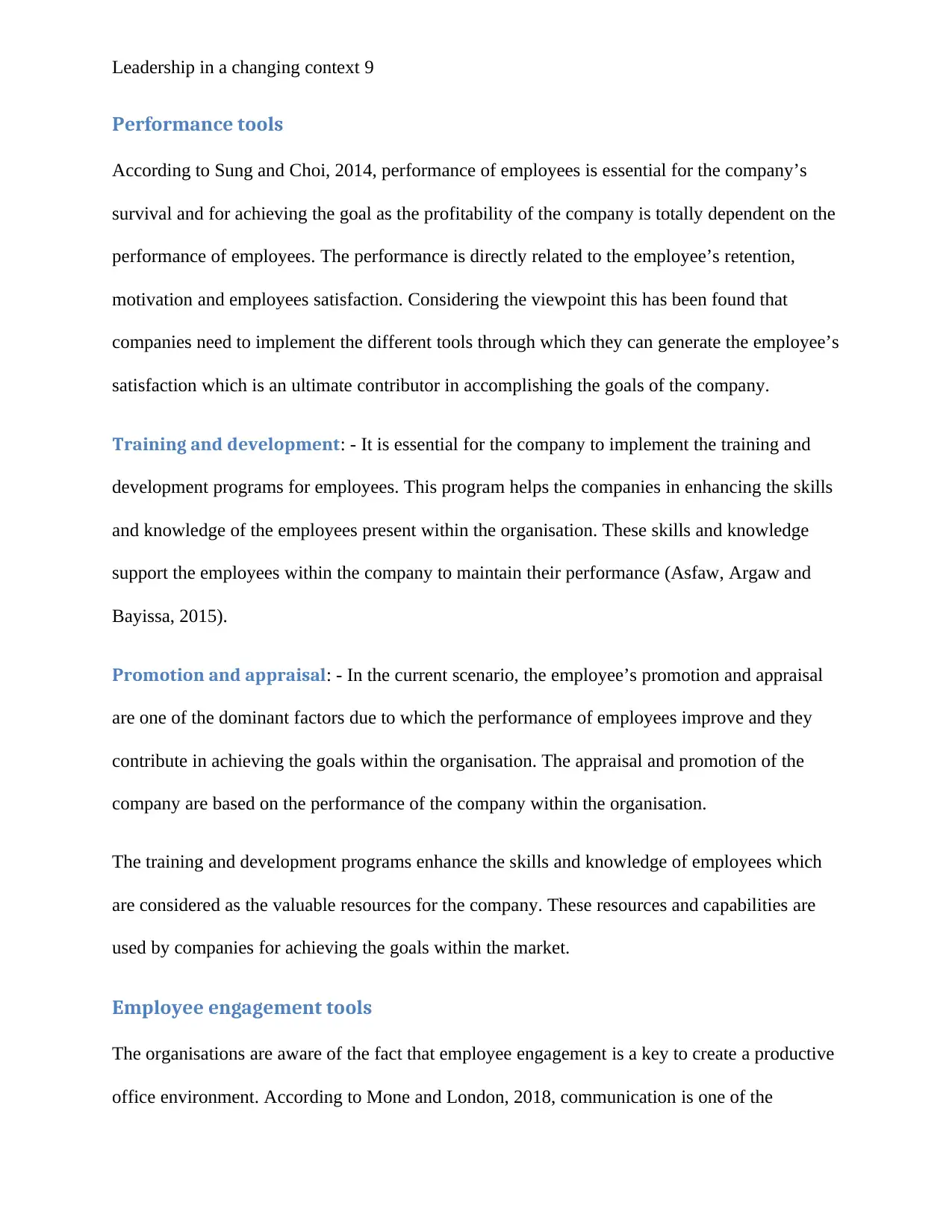
Leadership in a changing context 9
Performance tools
According to Sung and Choi, 2014, performance of employees is essential for the company’s
survival and for achieving the goal as the profitability of the company is totally dependent on the
performance of employees. The performance is directly related to the employee’s retention,
motivation and employees satisfaction. Considering the viewpoint this has been found that
companies need to implement the different tools through which they can generate the employee’s
satisfaction which is an ultimate contributor in accomplishing the goals of the company.
Training and development: - It is essential for the company to implement the training and
development programs for employees. This program helps the companies in enhancing the skills
and knowledge of the employees present within the organisation. These skills and knowledge
support the employees within the company to maintain their performance (Asfaw, Argaw and
Bayissa, 2015).
Promotion and appraisal: - In the current scenario, the employee’s promotion and appraisal
are one of the dominant factors due to which the performance of employees improve and they
contribute in achieving the goals within the organisation. The appraisal and promotion of the
company are based on the performance of the company within the organisation.
The training and development programs enhance the skills and knowledge of employees which
are considered as the valuable resources for the company. These resources and capabilities are
used by companies for achieving the goals within the market.
Employee engagement tools
The organisations are aware of the fact that employee engagement is a key to create a productive
office environment. According to Mone and London, 2018, communication is one of the
Performance tools
According to Sung and Choi, 2014, performance of employees is essential for the company’s
survival and for achieving the goal as the profitability of the company is totally dependent on the
performance of employees. The performance is directly related to the employee’s retention,
motivation and employees satisfaction. Considering the viewpoint this has been found that
companies need to implement the different tools through which they can generate the employee’s
satisfaction which is an ultimate contributor in accomplishing the goals of the company.
Training and development: - It is essential for the company to implement the training and
development programs for employees. This program helps the companies in enhancing the skills
and knowledge of the employees present within the organisation. These skills and knowledge
support the employees within the company to maintain their performance (Asfaw, Argaw and
Bayissa, 2015).
Promotion and appraisal: - In the current scenario, the employee’s promotion and appraisal
are one of the dominant factors due to which the performance of employees improve and they
contribute in achieving the goals within the organisation. The appraisal and promotion of the
company are based on the performance of the company within the organisation.
The training and development programs enhance the skills and knowledge of employees which
are considered as the valuable resources for the company. These resources and capabilities are
used by companies for achieving the goals within the market.
Employee engagement tools
The organisations are aware of the fact that employee engagement is a key to create a productive
office environment. According to Mone and London, 2018, communication is one of the
Paraphrase This Document
Need a fresh take? Get an instant paraphrase of this document with our AI Paraphraser
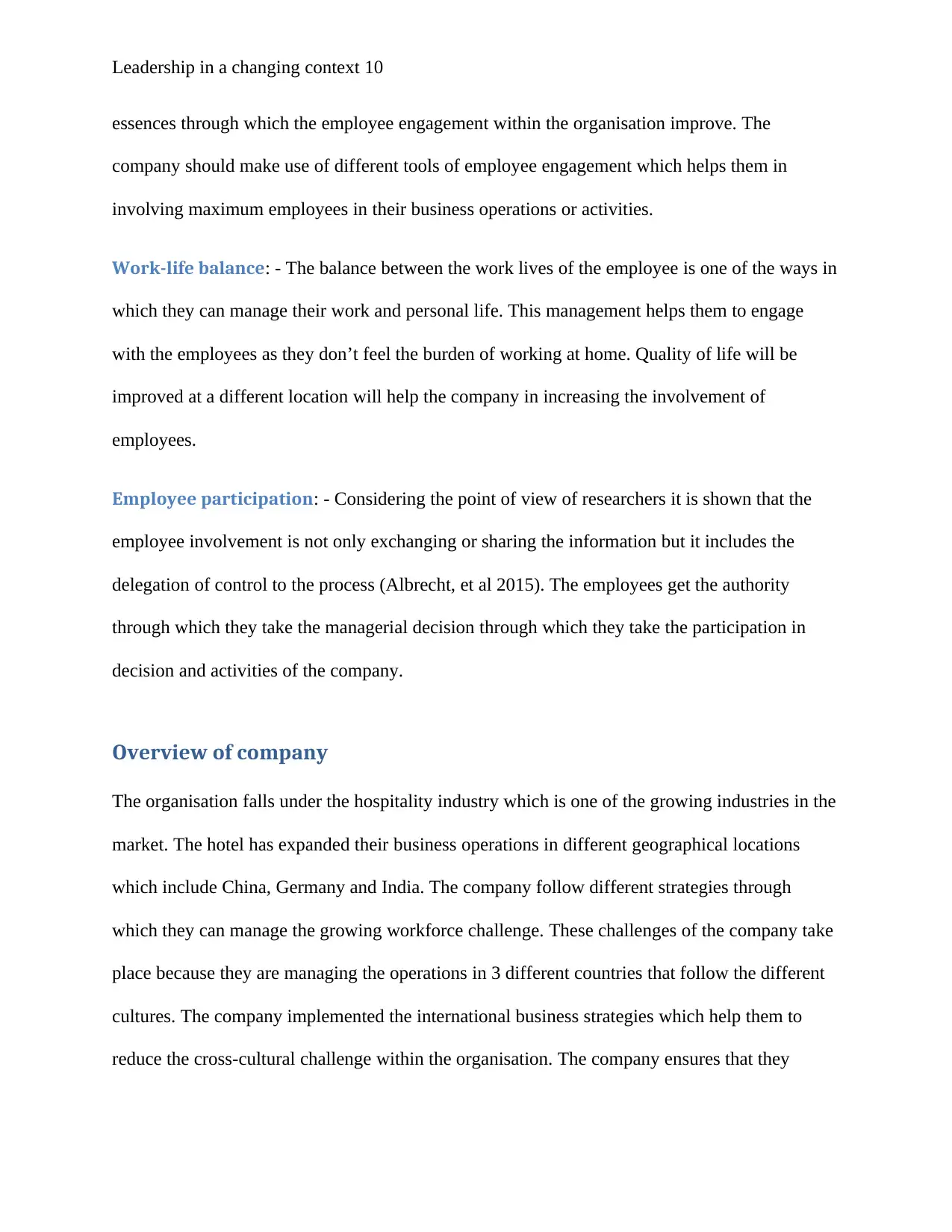
Leadership in a changing context 10
essences through which the employee engagement within the organisation improve. The
company should make use of different tools of employee engagement which helps them in
involving maximum employees in their business operations or activities.
Work-life balance: - The balance between the work lives of the employee is one of the ways in
which they can manage their work and personal life. This management helps them to engage
with the employees as they don’t feel the burden of working at home. Quality of life will be
improved at a different location will help the company in increasing the involvement of
employees.
Employee participation: - Considering the point of view of researchers it is shown that the
employee involvement is not only exchanging or sharing the information but it includes the
delegation of control to the process (Albrecht, et al 2015). The employees get the authority
through which they take the managerial decision through which they take the participation in
decision and activities of the company.
Overview of company
The organisation falls under the hospitality industry which is one of the growing industries in the
market. The hotel has expanded their business operations in different geographical locations
which include China, Germany and India. The company follow different strategies through
which they can manage the growing workforce challenge. These challenges of the company take
place because they are managing the operations in 3 different countries that follow the different
cultures. The company implemented the international business strategies which help them to
reduce the cross-cultural challenge within the organisation. The company ensures that they
essences through which the employee engagement within the organisation improve. The
company should make use of different tools of employee engagement which helps them in
involving maximum employees in their business operations or activities.
Work-life balance: - The balance between the work lives of the employee is one of the ways in
which they can manage their work and personal life. This management helps them to engage
with the employees as they don’t feel the burden of working at home. Quality of life will be
improved at a different location will help the company in increasing the involvement of
employees.
Employee participation: - Considering the point of view of researchers it is shown that the
employee involvement is not only exchanging or sharing the information but it includes the
delegation of control to the process (Albrecht, et al 2015). The employees get the authority
through which they take the managerial decision through which they take the participation in
decision and activities of the company.
Overview of company
The organisation falls under the hospitality industry which is one of the growing industries in the
market. The hotel has expanded their business operations in different geographical locations
which include China, Germany and India. The company follow different strategies through
which they can manage the growing workforce challenge. These challenges of the company take
place because they are managing the operations in 3 different countries that follow the different
cultures. The company implemented the international business strategies which help them to
reduce the cross-cultural challenge within the organisation. The company ensures that they
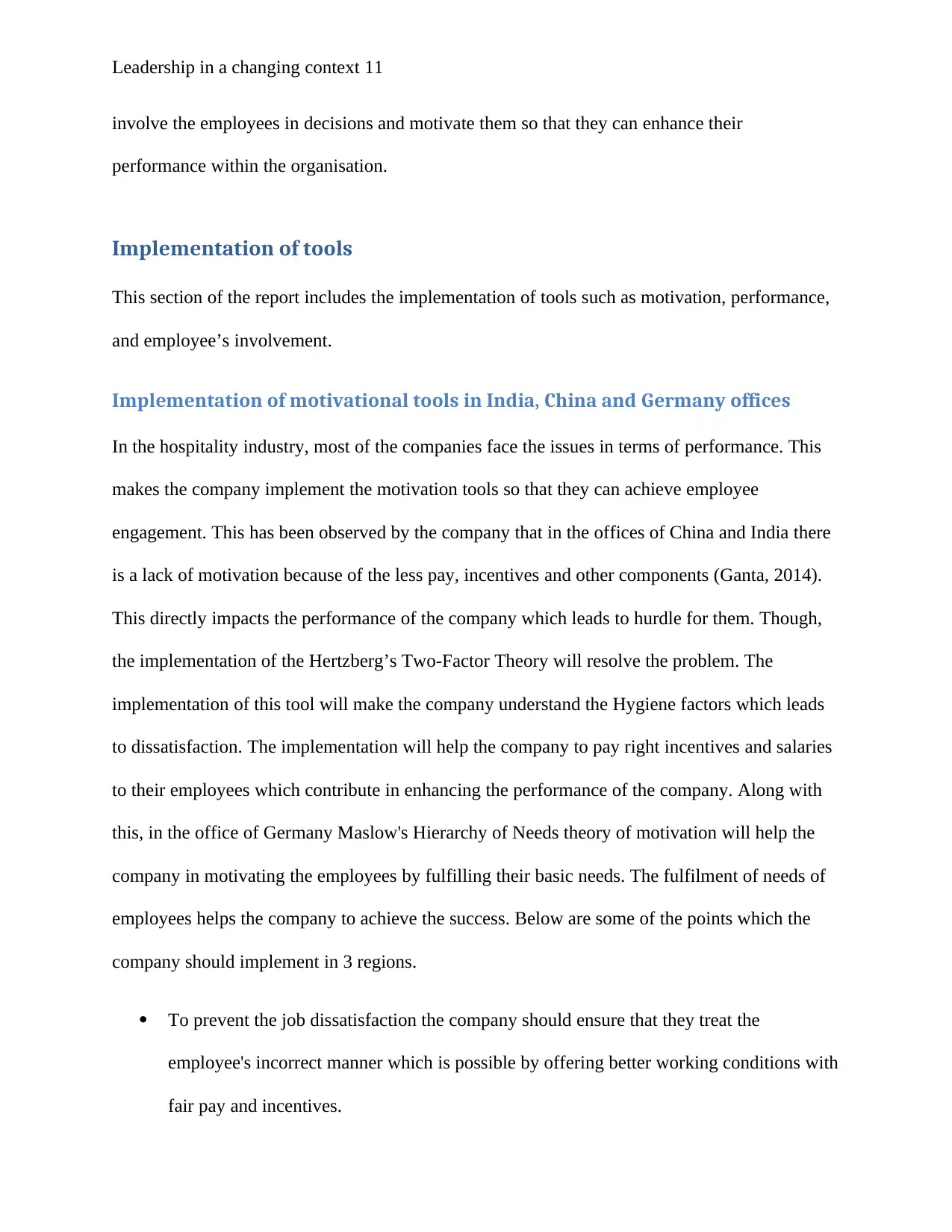
Leadership in a changing context 11
involve the employees in decisions and motivate them so that they can enhance their
performance within the organisation.
Implementation of tools
This section of the report includes the implementation of tools such as motivation, performance,
and employee’s involvement.
Implementation of motivational tools in India, China and Germany offices
In the hospitality industry, most of the companies face the issues in terms of performance. This
makes the company implement the motivation tools so that they can achieve employee
engagement. This has been observed by the company that in the offices of China and India there
is a lack of motivation because of the less pay, incentives and other components (Ganta, 2014).
This directly impacts the performance of the company which leads to hurdle for them. Though,
the implementation of the Hertzberg’s Two-Factor Theory will resolve the problem. The
implementation of this tool will make the company understand the Hygiene factors which leads
to dissatisfaction. The implementation will help the company to pay right incentives and salaries
to their employees which contribute in enhancing the performance of the company. Along with
this, in the office of Germany Maslow's Hierarchy of Needs theory of motivation will help the
company in motivating the employees by fulfilling their basic needs. The fulfilment of needs of
employees helps the company to achieve the success. Below are some of the points which the
company should implement in 3 regions.
To prevent the job dissatisfaction the company should ensure that they treat the
employee's incorrect manner which is possible by offering better working conditions with
fair pay and incentives.
involve the employees in decisions and motivate them so that they can enhance their
performance within the organisation.
Implementation of tools
This section of the report includes the implementation of tools such as motivation, performance,
and employee’s involvement.
Implementation of motivational tools in India, China and Germany offices
In the hospitality industry, most of the companies face the issues in terms of performance. This
makes the company implement the motivation tools so that they can achieve employee
engagement. This has been observed by the company that in the offices of China and India there
is a lack of motivation because of the less pay, incentives and other components (Ganta, 2014).
This directly impacts the performance of the company which leads to hurdle for them. Though,
the implementation of the Hertzberg’s Two-Factor Theory will resolve the problem. The
implementation of this tool will make the company understand the Hygiene factors which leads
to dissatisfaction. The implementation will help the company to pay right incentives and salaries
to their employees which contribute in enhancing the performance of the company. Along with
this, in the office of Germany Maslow's Hierarchy of Needs theory of motivation will help the
company in motivating the employees by fulfilling their basic needs. The fulfilment of needs of
employees helps the company to achieve the success. Below are some of the points which the
company should implement in 3 regions.
To prevent the job dissatisfaction the company should ensure that they treat the
employee's incorrect manner which is possible by offering better working conditions with
fair pay and incentives.
⊘ This is a preview!⊘
Do you want full access?
Subscribe today to unlock all pages.

Trusted by 1+ million students worldwide
1 out of 19
Related Documents
Your All-in-One AI-Powered Toolkit for Academic Success.
+13062052269
info@desklib.com
Available 24*7 on WhatsApp / Email
![[object Object]](/_next/static/media/star-bottom.7253800d.svg)
Unlock your academic potential
Copyright © 2020–2025 A2Z Services. All Rights Reserved. Developed and managed by ZUCOL.





